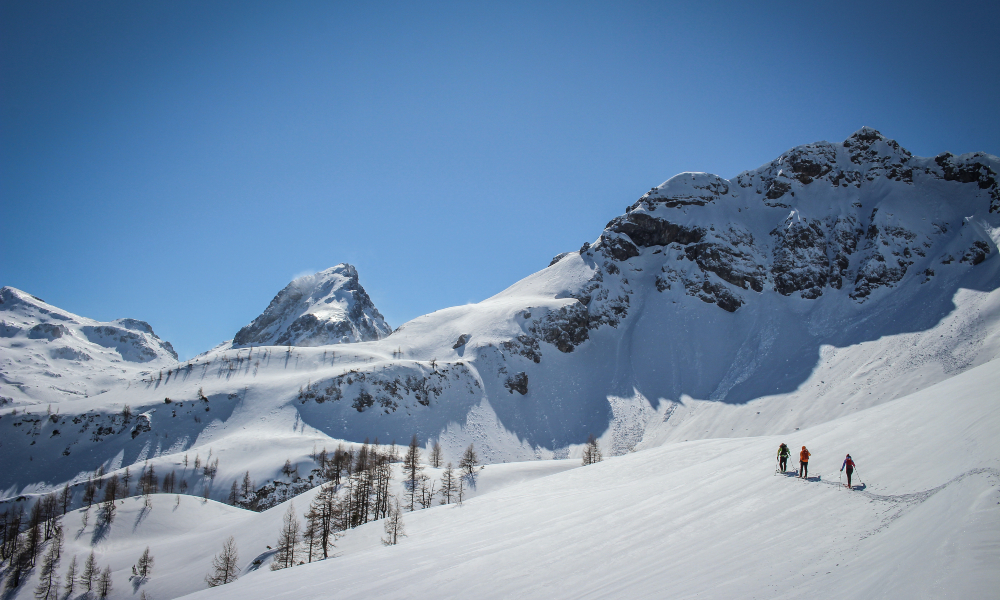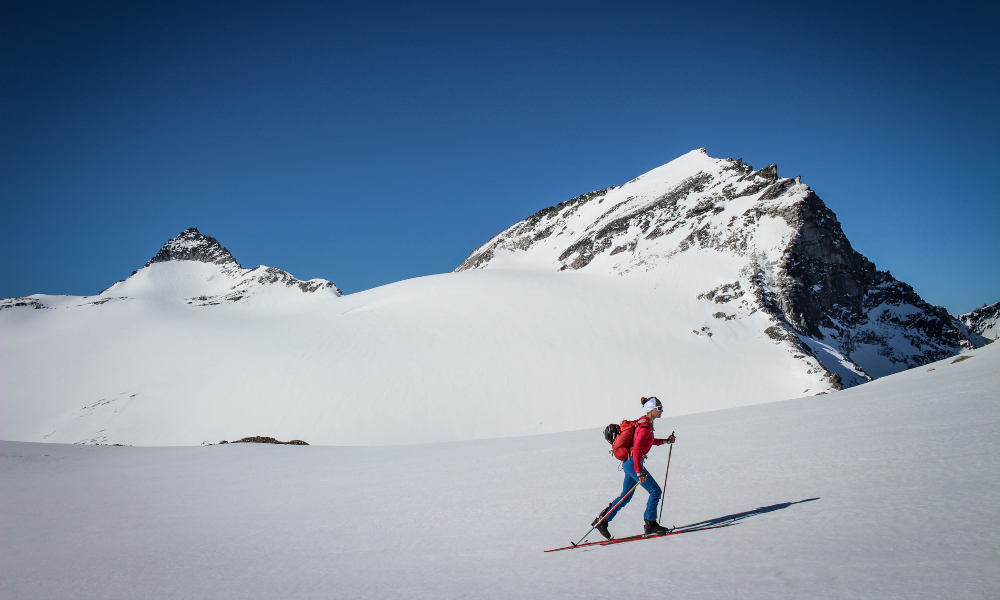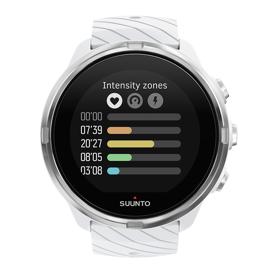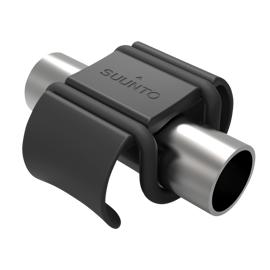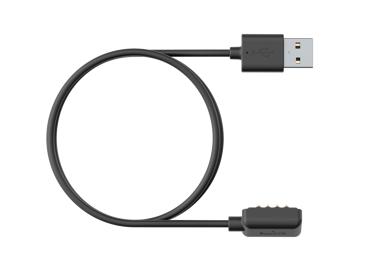Sports scientist, coach and blogger Susi Kraft grew up in the Austrian Alps and fell in love with ski mountaineering early. Her dad was her first skiing coach, and since studying sports science at university she’s been fascinated by how to train to get faster.
“Being faster makes it more fun, means you can climb more mountains, and gives you more options,” Susi says. “It also means you have safer conditions, lower avalanche risk, if you head out in the early morning and are fast enough to get back before midday when it usually gets warmer and changes the snowpack. Being faster also makes it possible to climb high mountains in one push – without the need to sleep in a hut.”
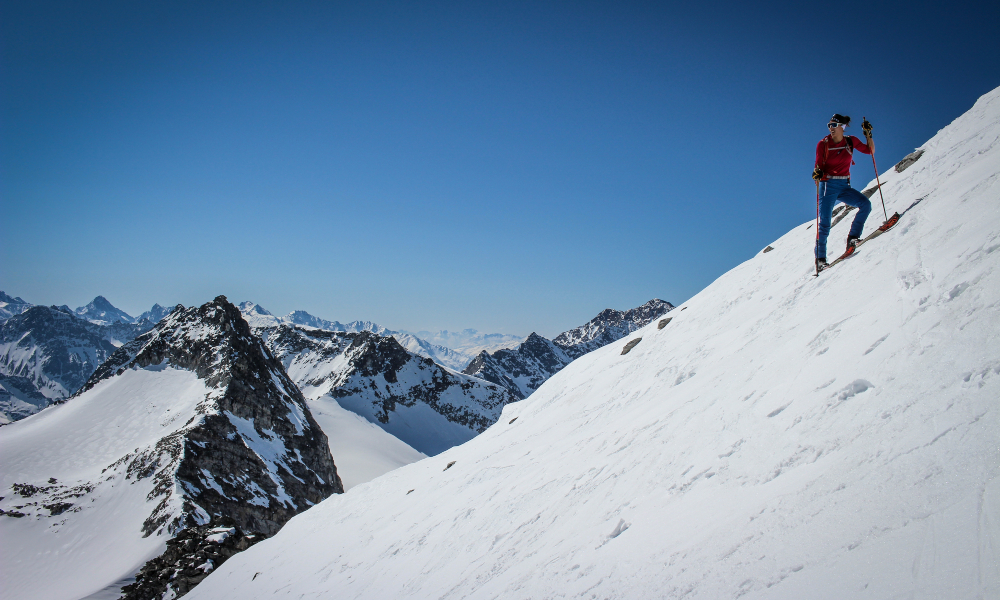
Every opportunity, Susi is out in the mountains around Salzburg.
The most beautiful and demanding
Susi is one half of the popular German language skimo blog Berghasen, which covers gear, training to tips, and awesome tours in the Alps. She coaches everything from trail runners and triathletes through to ski mountaineers. Getting faster at skimo is one of the most challenging things to achieve because it’s such a demanding sport.
“There are so many factors,” she says. “Endurance, technique for uphill and downhill, the environment, snow, mountains, cold, avalanche risk, fuelling, what to drink, and safety. The sport demands a lot of experience in advance. There are a lot of factors to staying safe and getting better. That’s why for me it’s the most beautiful sport, but one of the hardest to achieve the next level.”
Read on for Susi’s six tips to improve your uphill skimo speed.
Follow the 80/20 rule
“With skimo it’s really hard to train carefully because as soon as you go uphill your heart rate peaks,” Susi says. “It’s easy to slip into high intensity training and then over time your improvements will start to plateau. Also, having to carry much more gear in comparison to other sports such as trail running makes it really hard to train at lower intensity.”
Skiing and avalanche equipment, a backpack with food and drink, ski clothing and helmet all add up the weight to make the sport demand more strength and power, and to make it tough, especially for beginners, to keep the heart rate down.
Susi recommends following the polarised training model propounded by sports scientist Dr. Stephen Seiler. This is based on Seiler’s research that found the best endurance athletes do most of their training at low intensity. It suggests 80 % of training should be done at low intensity, and only 20 % at high intensity.
A key factor in getting a feeling about your training intensity is knowing your maximum heart rate. It can be determined by doing a lactate performance diagnostic test on a treadmill or bicycle ergometer. Your heart rate is the easiest way to monitor your training intensity and can be used in most sports. If you already know your maximum heart rate you can follow these training suggestions:
Train at least 80 % of the training at low intensity – about 70 % of your maximum heart rate
Maximum 20 % of your training volume should be high intensity – about 80 to 100 % of your maximum heart rate
To sum it up, follow this rule: do a lot of training in your comfort zone with low heart rate and a little bit of your training at really high intensity with your heart rate close to your maximum.
Reduce weight
As we mentioned before, skimo involves a lot of gear, and the weight of all that gear and provisions slows you down or increases your heart rate. Looking for ways to cut that down is essential. Susi recommends investing in lighter skis and ski boots as a start, and then looking into what other lighter weight gear you can find.
“If you really reduce weight you will notice your heart rate doesn’t get as high,” Susi says. “You will be able to do longer and more demanding climbs and you won’t get fatigued so quickly. Your recovery time after a long skimo day will also be less if your training session isn’t that intense.”
Embrace the flat
To help avoid slipping into high intensity training tours, look for maps and routes that don’t have so much elevation gain and avoid steep uphills.
“Look for terrain with just moderate steepness,” Susi says. “It will help to keep your heart rate down. Try to keep the inclination as low as possible, and use it as a warm up. Then keep some capacity for the last part of the mountain.”
Another option for low intensity training is doing some of your sessions on the bike outdoors or indoors on a bicycle ergometer. With biking it’s easier keeping the intensity low and the heart rate down than while running or ski mountaineering, Susi says.
Mix it up
If you’re having trouble keeping your heart rate in a low intensity zone on your tours, then mix it up and improve your base fitness by doing low intensity running in flat terrain and cycling. Remember, elite athletes like Kilian Jornet spent years working on their base. There are no shortcuts. Take your time and enjoy the process.
Build strength
Strength and core training are important for any sports, as they improve physical performance and are a key factor in preventing injuries like ruptures of ligaments in your knee.
“With more strength in your legs and core, uphill climbing will get easier,” Susi says. “Do two strength sessions a week with higher loads and don’t forget about core training!”
For building up muscles in your legs Susi recommends doing at least three sets of eight to 12 repetitions of:
- box jumps
- squats
- lunges
- leg press
- deadlifts
- hip thrusters
Beginners should do these exercises without additional weight. “The more experienced in strength training you get, the more additional weight you may use”, Susi says. Use barbells, kettlebells, dumbbells, weights plates or sandbags to intensify your strength training.
If you want to work on your core-stability and upper body d o exercises like push-ups, planking (frontal and side), good mornings, bridging or sit-ups. Check out Susi’s blog for more inspiration on core exercises. The articles are in German, but you can see the images here.
Do HIIT training
As mentioned, at least 80 % of your endurance training should be done at low intensity at around 70 % of your maximum heart rate. So what about the remaining 20 % of your training volume?
For athletes with a long history in low intensity training and for people with an excellent endurance base, high intensity interval training (HIIT) may improve your endurance even more.
“Just use a little bit to spice up your long and low intensity sessions, but don’t push it”, Susi cautions. “One or two sessions per week during the preparation for your competition or season highlight are totally fine.”
High intensity interval training is characterised by short and intense periods of exercise followed by less intense recovery periods where you continue the exercise with lower intensity. For example, running at maximum speed for one minute followed by easy running for one minute, and repeating this 15 times.
“As high intensity interval training is really intense the sessions usually have a shorter duration compared to ordinary and low intensity endurance training,” Susi says. “Keeping it to 25 to 40 minutes of hard intervals is totally fine.”
Follow one these HIIT regimens for skimo:
30 x 30 seconds at maximum intensity followed by 30 seconds of active rest at low intensity
15 x 1 minutes intervals at maximum intensity followed by 1 minute of active rest
8 x 3 minutes intervals at high intensity followed by 3 minutes of active rest (low intensity)
5 x 4 minutes intervals at high intensity followed by 3 minutes of active rest
4 x 5 minutes at high intensity followed by 5 minutes at low intensity
3 x 8 minutes at high intensity followed by 5 minutes at low intensity
Note: start your HIIT with a 10 minutes warm-up and a 10 minutes cool down at low intensity. The day after a high intensity session you should schedule a rest day or an easy recovery session.
All images: © www.berhasen.com
